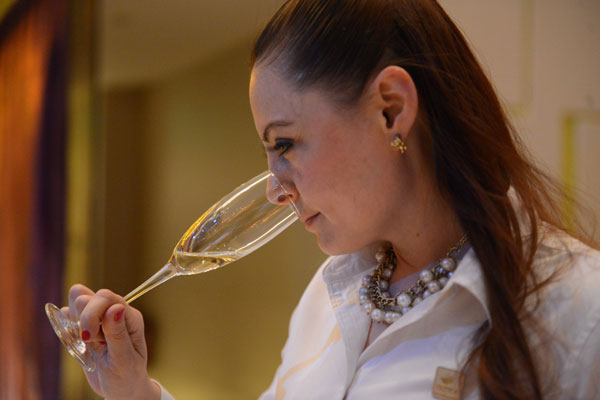Latin spirit
 |
|
Alba Aviles, tequila's regulatory official for Asia, demonstrates how to appreciate a good tequila. [Photo by Bruno Maestrini/China Daily] |
For those who usually sip their tequila in a fruity margarita, the premium tequila in the raw is a revelation, with its faint nose of vanilla echoed in the flavor. There is a surprising softness in the mouth feel.
We are sampling aged tequila (reposado), the middle grade of tequila's five classes. Cocktail drinkers are most familiar with white (silver) or yellow (gold) types, while those who savor a quality shot straight tend to explore the three classes that are defined by how long they are aged in wood barrels. Reposado tequilas, for example, must be aged for at least two months; if they are in the barrels longer, they acquire more golden color and a higher grade - extra-aged, or anejo.
Beyond the five classes (see box), there are two broad categories of tequila. Premium tequila is 100-percent blue agave, and it's fairly new to Chinese drinkers. In June 2013, after a state visit to Mexico by President Xi Jinping, a ban on importing premium tequilas into China was lifted, and the good stuff started arriving two months later, when more than 70,000 bottles from 10 brands landed in Shanghai. The arrival was celebrated at the House of Roosevelt, a famous club on the Bund, and trade officials said at the time they expected Mexico's tequila exports - a robust 170 million liters in 2013 - to jump 20 percent within a decade.
"Regular" tequila, legally defined as made with 51 percent of its distilled sugars from the blue agave plant, has been in China longer.
"There are about 300 kinds of agave plants," Avila tells sippers at a Mexican-embassy sponsored food festival recently at the Beijing Hilton. "But only alcohol made from the blue agave can be labeled tequila. The others can be used to make other liquors, also popular in Mexico, such as mescal."
Like wine, tequila has terroir: Plants harvested from a hillside, for example, will absorb different minerals and contain more sugar than their flatland siblings, because the ratio of water to sunlight will be better (lower).
As she relates how tequila can only come from the volcanic soils of Jalisco and four other Mexican states, Avila's talk is peppered with the words and phrases of a sommelier.


















